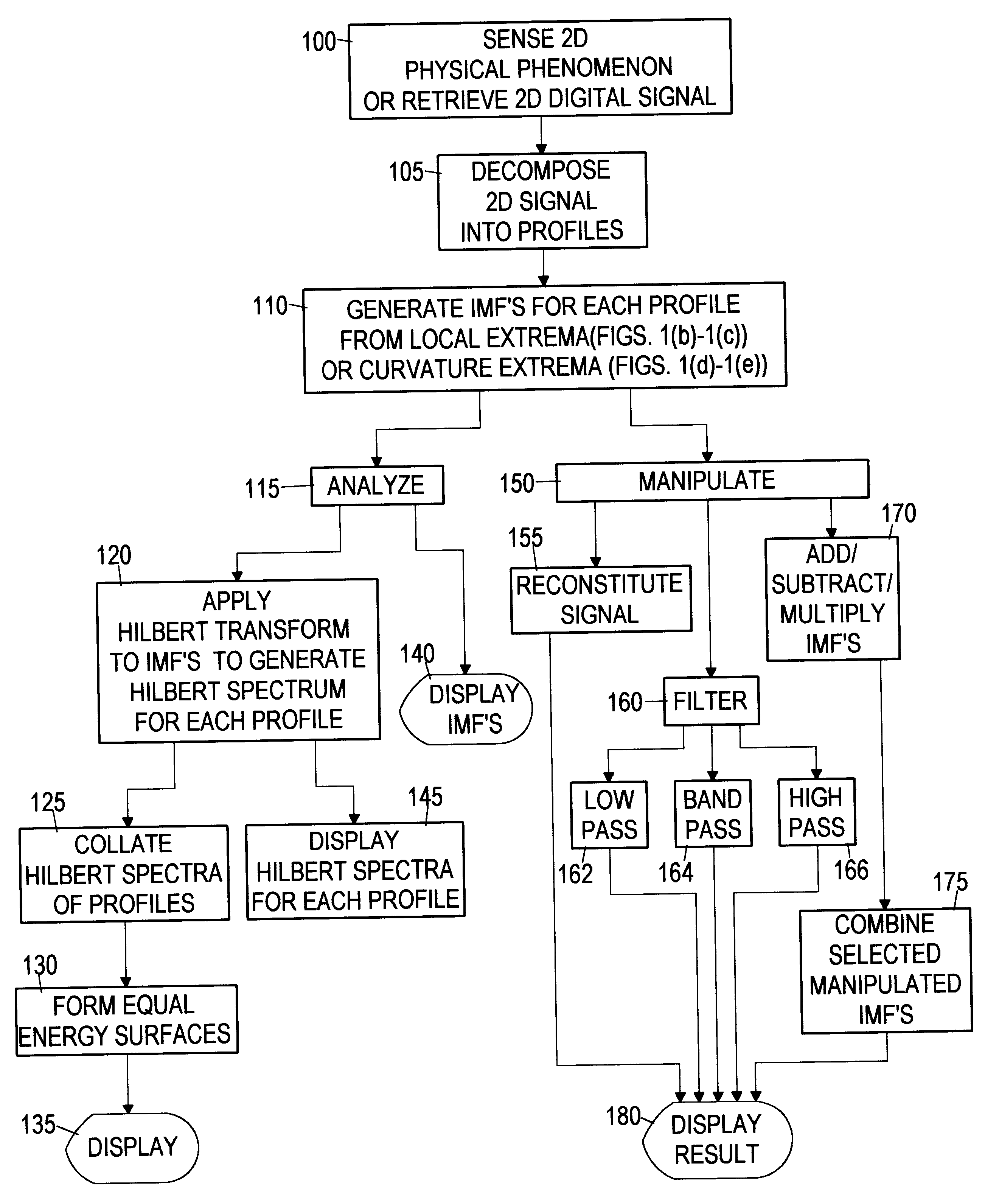Analyzing physical signals is a difficult problem confronting many industries.
Unfortunately, previous methods have not yielded results which are physically meaningful.
(a) The total data span is too short;
(b) The data are nonstationary; and
(c) The data represent nonlinear processes.
Although problems (a)-(c) are separate issues, the first two problems are related because a data section shorter than the longest time scale of a stationary process can appear to be nonstationary.
This assumption may lead to inaccurate results and incorrect interpretation of the underlying
physics as explained below.
Although the
Fourier transform that is applied by these computer implemented methods is valid under extremely general conditions, there are some crucial restrictions: the
system must be linear, and the data must be strictly periodic or stationary.
If these conditions are not met, then the resulting spectrum will not make sense physically.
Furthermore, imperfect probes / sensors and numerical schemes may contaminate data representative of the phenomenon.
Under these conditions, computer implemented methods which apples Fourier
spectral analysis are of limited use.
For lack of alternatives, however, such methods still apply Fourier
spectral analysis to process such data.
Moreover, the indiscriminate use of Fourier
spectral analysis in these methods and the adoption of the stationary and linear assumptions may give misleading results some of which are described below.
Thus, the Fourier components might make mathematical sense, but they often do not make physical sense when applied.
Although no physical process can be represented exactly by a
delta function, some physical data such as the near field strong
earthquake energy signals are of extremely
short duration.
Furthermore, both nonstationarity and nonlinearity can induce spurious
harmonic components that cause unwanted energy spreading and artificial frequency smearing in the
Fourier spectrum.
The consequence is incorrect interpretation of physical phenomenon due to the misleading energy-frequency distribution for nonlinear and nonstationary data representing the physical phenomenon.
According to the above background, the state of the art does not provide a useful computer implemented tool for analyzing nonlinear, nonstationary physical signals.
Therefore, like the one-dimensional
data processing techniques described above, the conventional
processing techniques are simply inadequate to process such two-dimensional data.
However, many images contain inhomogeneous scales which cannot be satisfactorily separated, analyzed or processed by conventional
image processing methods.
These problems include inaccurate interpretation of the underlying
physics caused in part by energy spreading and frequency smearing in the
Fourier spectrum.
With the
physical approach and the approximation adopted here, the inventive method does not always guarantee a perfect instantaneous frequency under all conditions.
Other than these theoretical difficulties, on the practical side, serious problems of the spline fitting can occur near the ends, where the cubic spline fitting can have large swings.
Left by themselves, the end swings can eventually propagate inward and corrupt the whole data span especially in the
low frequency components.
Unfortunately, the effects of the second condition, when carried to the extreme, could obliterate the physically meaningful amplitude fluctuations.
Although the mean can be treated as a zero reference, defining it is difficult, for the whole process is transient.
The components with the highest frequencies add little more energy, but they make the data look more complicated.
In fact, the highest frequency component is probably not physical, for the digitizing rate of the Pitot tube is too slow to capture the
high frequency variations.
Although this local extrema Sifting Process is an excellent tool, it has difficulty analyzing a
composite signal or profile having a
weak signal component that cannot itself generate local extrema in the
composite signal.
Furthermore, the Rice definitions cannot be applied to nonlinear and / or nonstationary data.
Because of the limitations set forth in Rice's assumptions, his results have also created some paradoxes: in may data sets, the number of the expected extrema computed from the above formula becomes unbounded.
This dilemma, however, has not alerted investigators to question Rice's formulae and the assumptions involved, but it has led most to reject any formula that involves moments higher than the 4th.
Such an approach limited the past statistical measure of time scale to the computation of zero-crossings which is too crude to be of any real use.
Refined as the extrema criterion is, it still lacks precision sometimes. By examining the data in closer detail, it can be found that the extrema spacing can miss some subtle time scale variations especially when a
weak signal oscillation is overwhelmed by a larger oscillation.
As described above, the local extrema statistics has encountered difficulties already.
Fortunately, this difficulty is an artifact and the consequence of the linear and stationary assumptions invoked.
Consequently, the failure of the Rice model is another indication of the falsehood of the commonly invoked
linearity and stationarity assumptions.
Since the sub-
modes are all weak, it is impossible to extract them from the data by applying the local extrema Sifting Process.
Furthermore, the curvature extrema Sifting Process should be monitored carefully especially when the
signal to noise ratio of the physical signal is low which could result in
noise corruption and false readings.
Although the Hilbert transform can treat the monotonic trend as part of a longer oscillation, the energy involved in the residual trend could be overpowering.
Furthermore, a lower
frequency resolution saves computation time for the computer implemented method.
Although the Hilbert Transform can treat the monotonic trend as part of a longer oscillation, the energy involved in the residual trend could be overpowering.
Furthermore, the
wavelet result fails to capture the higher energy near the initial line along the y axis.
The thickness of these slabs indicates the poor frequency resolving power of the conventional
wavelet techniques.
Although the
satellite image shows many details of the hurricane cloud formation, the contrast is not high enough to clearly define the detailed cloud swirl streaks.
 Login to View More
Login to View More  Login to View More
Login to View More 


